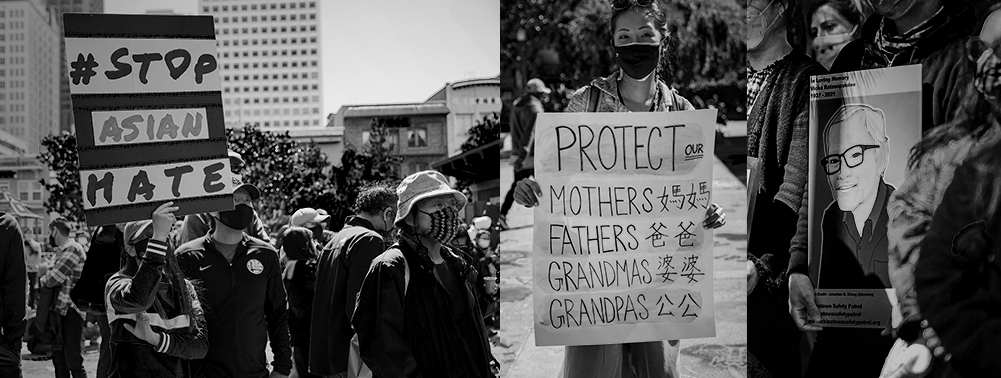Silent No More. Immediate Actions that Brands Can Take to Help #StopAsianHate

The Asian American community is outraged, devastated, and fearful after the killing spree in Atlanta that took the lives of eight innocent people, six of whom were Asian women. The victims’ names are Delaina Ashley Yaun, 33; Paul Andre Michels, 54; Xiaojie Tan, 49; Daoyou Feng, 44; Young A. Yue, 63; Suncha Kin, 69; Soon C. Park, 74; and most recently identified, Hyun Jung Grant, mother of two sons. It feels important to say their names. Families have been destroyed, and the possibility haunts millions across the nation, “it could have just as easily been my loved ones or me.” With a 150% increase of hate crimes targeting Asian Americans, that concern is justified.
One issue that continues to be voiced within the Asian American community is the shame and frustration surrounding identity. To be forced to consider hiding who we are or bending our heads in submission, not go outside, not to speak our languages – is this our future, to live a half-life? Does standing strong mean putting ourselves in harm’s way? Hate has found an excuse to simmer over the top as blame placed on the Asian community for the spread of coronavirus continues to grow across the U.S.
Imagine the anger and strength it would have taken for the brave 76-year-old Xiao Zhen Xie to fight back against her attacker despite being physically assaulted in broad daylight. While we hail her for her courage, her bruises are a glaring reminder of the deep-seated hate that has resided in America’s dark underbelly for generations.
In addition to these violent attacks, disproportionate financial hardships resulting from the loss of jobs and businesses have also been a painful reality for the Asian American segment. Asian-owned businesses have lost 50% to 70% of revenue since the pandemic. The segment faced the largest share of long-term unemployment rates, i.e., for at least 27 weeks, compared to all ethnic groups in the fourth quarter of 2020. Roughly 25% of the Asian American segment works in hardest-hit sectors like retail, hospitality, leisure, and other services such as salons and dry cleaners.
The Asian American community is looking for actions from brands to help fight hate crime and support the community. Words of support from brands are essential but not enough. Long-term commitments to back the Asian community, its businesses, and people are missing – commitments that entail much more than celebrating the Asian Pacific American Heritage Month once a year.
Here are three ways through which you can take decisive steps to make a real difference.
- ADVOCACY. Hollow words speak volumes. Supporting the Asian American community long-term through advocacy and action is essential.
- Donations: Brands can create their charitable program to fund the struggling Asian-owned businesses, similar to Hennessy’s Unfinished Business. Alternatively, brands can also help fund Asian-owned organizations fighting against racist rhetoric or rebuilding and supporting businesses and other parts of Asian communities particularly hit by the pandemic. Some of the organizations are listed below:
- Stop AAPI Hate: This nonprofit, created in March 2020, tracks and responds to incidents of hate, violence, harassment, discrimination, shunning, and child bullying.
- Asian Pacific Fund: Provides grants for senior and youth services, health and well-being, counseling, legal services, advocacy, civic engagement, and arts and culture.
- Asian Americans Advancing Justice: An organization dedicated to building a more fair and equitable society through education, litigation, and public policy advocacy.
- Heart of Dinner: Works to combat food insecurity and isolation within NYC’s elderly Asian American community.
- National Asian Pacific American Women’s Forum: The organization is mobilizing and building power in 14 cities across the United States to create social, political, and economic change for AAPI women and girls.
- Public awareness campaign: Think beyond a one-off support message on social media. Instead, dedicate resources and airtime to work with community organizations and agencies to create assertive communication that inspires others to follow. An example is the Love Has No Labels campaign launched by the Ad Council. It promotes acceptance and appreciation of all communities regardless of race, religion, gender, sexuality, age, and ability by raising awareness for implicit biases.
- EMPLOYEE ENGAGEMENT. Corporate employees are not a passive audience. With proper education and awareness, they can potentially champion the cause, and further spread the message within their respective communities and circles. Establishing an internal allyship through a transparent and authentic content repository, one on one sessions, and frequent group discussions can bring to light a deeper context to ongoing anti-Asian sentiments and how to address them. Some of the pivots to employee content can include the following
- Historical Context: Understand the history of Asian Americans through personal stories and how these journeys have shaped their perspectives on their roles in this country.
- Quashing Prevalent Stereotypes: Talk about racial biases, misconceptions, and cultural appropriation that hurt the community.
- Safe Space to Speak: Create a platform for the Asian American workforce to voice their concerns, challenges, and fears freely.
- How to Protect Yourself: Provide a guide on tackling a potentially threatening situation and or racial attacks in the most effective way.
- Bystander Intervention Program: Provide a guide to playing a role in creating a safe public space when witnessing harassment.
- INCLUSION IN ACTION. The change we speak of can only happen if organizations readjust their frame of reference towards the Asian community. The actions brands take to normalize diversity and Asian representation in company business and operation are critical steps in building a long-term and sustainable diversity strategy.
- Supplier Diversity: Increase visibility and representation of Asian-owned suppliers and partners.
- Marketing Communication: Aside from increasing Asian American representation in general market communication, there is a pressing need to invest in understanding segment motivations and desires. The pandemic has changed Asian lives in more ways than expected, and the community is hurting. Hearing their voice and tailoring communication that meets their practical and emotional needs will go a long way to building brand perception and loyalty.
All things considered, fighting the systemic prejudice against the Asian American community is an uphill battle that requires continued support from the government, brands, and people. It is not going to be easy but let’s work together to make a start.
Cofounder&
ADMERASIA
Jeffl@admerasia.com
Racism Is Contagious by ADMERASIA – a platform that provides consolidated, impactful tools to combat the spread of hate crimes against the Asian American community. Visit https://racismiscontagious.com/ to learn more.
[R]EVOLUTION by ADMERASIA – a platform that connects brands with Asian American innovators and gamechangers rewriting the rules for social advocacy, content creation and entertainment. Visit www.admerasia.com/revolution to know more.


